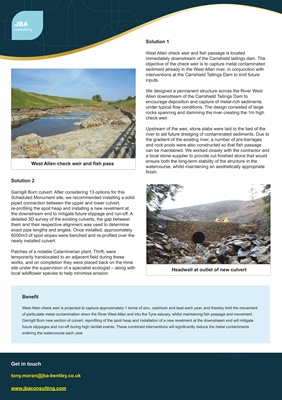
tony.moran@jba-bentley.co.uk
www.jbaconsulting.com
Get in touch
Benefit
West Allen check weir is projected to capture approximately 1 tonne of zinc, cadmium and lead each year, and thereby limit the movement
of particulate metal contamination down the River West Allen and into the Tyne estuary, whilst maintaining fish passage and movement.
Garrigill Burn new section of culvert, reprofiling of the spoil heap and installation of a new revetment at the downstream end will mitigate
future slippages and run-off during high rainfall events. These combined interventions will significantly reduce the metal contaminants
entering the watercourse each year.
Garrigill Burn culvert. After considering 13 options for this
Scheduled Monument site, we recommended installing a solid
piped connection between the upper and lower culvert,
re-profiling the spoil heap and installing a new revetment at
the downstream end to mitigate future slippage and run-off. A
detailed 3D survey of the existing culverts, the gap between
them and their respective alignment was used to determine
exact pipe lengths and angles. Once installed, approximately
6000m3 of spoil slopes were benched and re-profiled over the
newly installed culvert.
Patches of a notable Calaminarian plant, Thrift, were
temporarily translocated to an adjacent field during these
works, and on completion they were placed back on the mine
site under the supervision of a specialist ecologist - along with
local wildflower species to help minimise erosion.
Solution 1
Solution 2
West Allen check weir and fish passage is located
immediately downstream of the Carrshield tailings dam. The
objective of the check weir is to capture metal contaminated
sediment already in the West Allen river, in conjunction with
interventions at the Carrshield Tailings Dam to limit future
inputs.
We designed a permanent structure across the River West
Allen downstream of the Carrshield Tailings Dam to
encourage deposition and capture of metal-rich sediments
under typical flow conditions. The design consisted of large
rocks spanning and damming the river creating the 1m high
check weir.
Upstream of the weir, stone slabs were laid to the bed of the
river to aid future dredging of contaminated sediments. Due to
the gradient of the existing river, a number of pre-barrages
and rock pools were also constructed so that fish passage
can be maintained. We worked closely with the contractor and
a local stone supplier to provide cut finished stone that would
ensure both the long-term stability of the structure in the
watercourse, whilst maintaining an aesthetically appropriate
finish.
West Allen check weir and fish pass
Headwall at outlet of new culvert